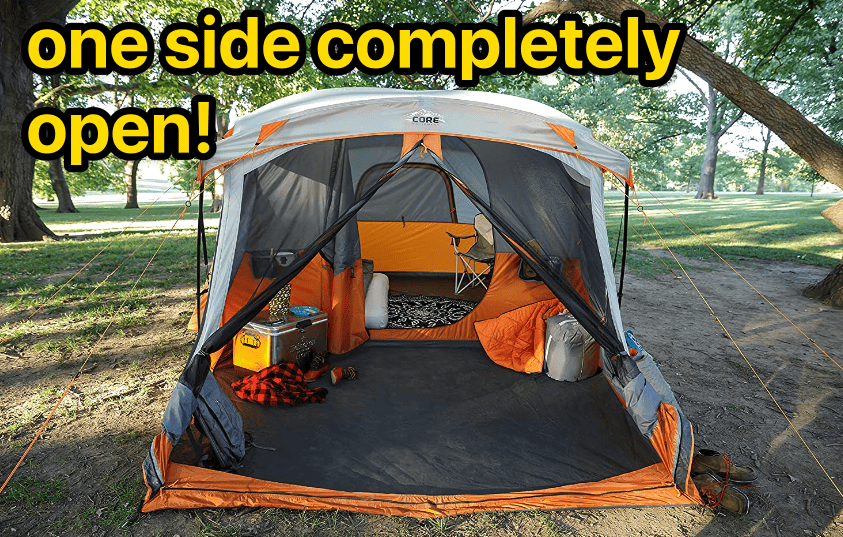SUMMARY: Mildew can be a common problem in tents but it’s manageable with the right preventive measures and cleaning techniques. Understanding the causes of mildew in tents and using appropriate solutions such as vinegar, lemon juice, or specialized commercial products can help keep your camping gear in top shape.
Ever harbored resentment against mildew for ruining your favorite tent?
Even the BEST, most expensive tents can leak & get mildew or mold.
Ew.
Here’s a sneak peek into what we are going to dive into:
- The life-saving skill of tent waterproofing 🌊🛡️
- Maximizing ventilation, without inviting the bugs in 🌬️🐜
- Becoming a detective: spotting mildew before it’s too late 🔍💡
- Safely sending Mildew packing—without damaging your tent 👋💨
- The “I wish someone had told me this before” common mistakes section you’ll want to bookmark 📖🚫
Join me in this wild, educational ride! 🙋♂️🎢🎪
The Importance of Tent Waterproofing
FIRST–let’s prevent mold/mildew.
Who knew waterproofing a tent could potentially save your camping trip, or better still, your favorite tent from our underestimated nemesis – mildew?
Waterproofing basics:
Just like we gear up for our own safety against weather surprises (Sudden pandemic outbreaks anyone? Oh, wait…no, just sudden downpours!), our tent deserves the same, if not more. Here’s a quick rundown of the process:
- Start by applying a waterproofing spray over the outer layer of the tent. It adds an additional layer of protection against moisture and, hence, against mildew. It’s like putting on a cape without having to worry about Edna Mode’s “No Capes” lectures. 🧥🚫
- Seam sealers can also come in handy for those vulnerable joints and corners (kinda like batarangs for your tent!). P.S.: Don’t forget to do this well in advance for the sealers to dry and work effectively against water exposure. 🎯🥽
We have 3 cans of this stuff👇
Tools and Techniques
Gather ‘round, campers. Let’s talk tools of the trade.
- You’ll need a trusty waterproofing spray, suitable for the material of your tent (Pro tip: read the labels, kids! 😁🏷️ )
- Seam sealers working their way into the nooks and corners should be your next pick.
- Remember you don’t need the Penguin to make weather predictions. Even clear days can have their surprises.
So much for peaceful stargazing!
Thanks to mildew, our camping experiences are not just about the joy of embracing the unknown, they also turn into a wild ride of “embrace and contain the unwelcome fungi”. But worry not, fellow adventurer, with your Batman skills of tent waterproofing, you’ll turn your camping trip into one where the only unwelcome guest would be a surprise rain shower, and not mildew! 🌧️🎪💪
Now, let’s move onto a topic that takes my breath away – ventilation! (And no, I’m not being dramatic. Lack of ventilation actually can take your breath away) 😜💨🌬️
Ventilation and Its Role in Preventing Mildew
Our next checkpoint in the mildew prevention journey takes us to the world of ventilation. As much as it feels like a warm, tightly-sealed tent is an excellent shield against the elements, it can leave room for a less than welcome guest – mildew.

The Crucial Role of Ventilation
Just as we humans depend on fresh, clean air to keep us healthy, our tents require proper ventilation to maintain their lifespan and prevent damage from pesky mildew.
- Ventilation acts as a natural deterrent against mildew by reducing the accumulation of humidity inside your tent.
- Humidity is nothing but a breeding ground for mildew and allowing this to build up inside your tent is the equivalent of rolling out a welcome mat for this unwelcome guest.
- Proper ventilation can decrease the overall moist environment which then decreases mildew growth.
The Methodology – Lower Windows and Air Flow
So, how do we accomplish the goal of a well-ventilated tent? The steps are surprisingly simple yet effective.
- Open those lower windows: This small act can drastically increase ventilation in your tent. How, you ask? Well, warm air rises and escapes through the top vent, drawing cooler air in from the lower windows. This circular movement contributes significantly to dryness and coolness inside the tent, preventing mildew from setting up shop.
- Keep air flowing: Regardless of the weather, it’s crucial to ensure that there’s always an air flow through your tent. No air movement equates to a stale, humid environment perfect for mildew growth. Whether it’s by using a camping fan or strategically positioning your tent to leverage the natural wind, keeping the air moving not only aids in mildew prevention but also adds an element of freshness to your camping experience.
A Personal Take on Ventilation
In my own camping escapades, I learned the value of ventilation the hard way. On a particularly cold night, I zipped up my tent completely to shield myself from the frigid, north wind. A few days later, I noticed an unpleasant smell and some ugly spots on my tent wall – mildew. Since then, I’ve made sure to maintain air flow, even in cooler weather, and the difference has been night and day!
Implementing these simple ventilation steps can keep your mind at ease and your camping experience mildew-free!
Dealing with Mildew – Detection and Removal
With prevention measures in place, let’s now focus on the detection and removal of mildew in your tent. Knowing how to identify it early on and effectively dealing with it can make the difference between quick recovery and discarding your favorite camping gear.
Detecting Mildew: Your First Line of Defense
Being able to spot mildew early is your top defense against major damage. Here’s how to do it:
- Smell the air: Mildew has a distinct musty odor. If your tent is giving off an odd, musty smell, it’s time to examine it for mildew.
- Visual inspection: Look for odd discolorations or spots on your tent fabric. Mildew usually manifests as grey, brown or black spots.
Mildew Removal Techniques: The Good, The Bad, and The Ugly
There’s no shortage of methods to remove mildew from your tent. However, not all are created equal.
Vinegar Solution
- Pros: This all-natural solution involves a mixture of white vinegar and water. It’s gentle on the tent fabric and is highly effective on mildew.
- Cons: The smell of vinegar can be strong and might remain for a while after cleaning.
Specialized Tent Cleaners
- Pros: These are formulated specifically for outdoor gear and are excellent for removing mildew without damaging your tent.
- Cons: They can be a bit more expensive than home remedies.
Bleach Solution
- Pros: A weak bleach solution is effective at removing mildew.
- Cons: Bleach can deteriorate and discolour the tent fabric over time. Use it sparingly and with caution.
Personal Insights on Mildew
I’ve had my fair share of battles with mildew. Each method has its merits but I personally find a vinegar solution to be the best bet for mildew removal (especially if it’s on the outside of tent, where the smell wouldn’t be a problem anyways!).
Yes, the smell is strong, but leaving the tent to air out for a bit after cleaning usually takes care of it.
Remember, effective mildew removal is not only about getting rid of the spots and smell. It’s also about ensuring the longevity and quality of your tent. Choose your method wisely!
Common Mistakes in Mildew Prevention and Removal
Even with the best intentions and correct information at hand, there are still potential pitfalls in the quest against mildew. Here are some common mistakes to avoid and how to sidestep them, blended in with a dash of humor and firsthand blunders.
Mistakes 101: What Not To Do
- Packing up your tent while it’s still wet: This might just be the most common mistake campers make. Dampness provides a great environment for mildew. My advice? No matter how eager you are to hit the road, let your tent dry out thoroughly.
- Ignoring a tiny spot of mildew: When it comes to mildew, you can’t afford to ignore even the tiniest spot. Like the villain in a bad movie, it only grows stronger the more you ignore it. Take my word for it.
- Failing to seal after cleaning: Once you’ve waged and won the war against mildew, it’s essential to seal your tent. This shields it against future mildew infestations and is like insurance against having to repeat the whole removal process.
Takeaway:
Having tackled the wide-ranging impacts and implications of mildew on tents, it’s evident how crucial it is for every camping enthusiast to take immediate and inclusive steps in preventing and dealing with mildew growth. The mildew tent issue is not only a test of resilience but also an avenue for boosting your camping experience and extending the lifespan of your camping gear.
From waterproofing, initiating proper ventilation, detecting and removing mildew to the common mistakes to avoid, this comprehensive guide provides you with all the necessary information. The next time you pack for a camping trip, remember:
- Waterproofing is integral: Waterproof the exterior of your tent to prevent moisture accumulation – the breeding ground for mildew.
- Ventilation is key: Keep the tent windows lower and ensure efficient air flow through your tent.
- Early detection of mildew saves: Catch the mildew growth early, and use safe techniques to remove it.
So, why not make your next camping experience mildew-free? Go out, apply these strategies, and witness the difference yourself!
FAQs about Mildew and Tents
What causes mildew on tents?
Mildew is typically caused by damp and hot conditions. If your tent is moist and improperly ventilated, chances are it could develop mildew over time.
Can mildew-damaged tents be repaired?
Yes, tents affected by mildew can be repaired. However, it’s important to detect the growth early for effective removal and treatment.
Can a waterproof tent still develop mildew?
Waterproofing your tent is an important step in mildew prevention, but a waterproofed tent can still develop mildew if stored damp or if there’s poor ventilation.
How often should I clean my tent to prevent mildew?
Regular cleaning helps prevent mildew. Clean your tent after every camping trip, making sure to air dry it completely before storage.
How can I ventilate my tent properly?
Ensure proper ventilation by keeping the tent’s windows lower and creating airflow. This can be done by keeping some windows or vents open, letting the air circulate effectively.
Reminiscing about soggy sleeping bags and musty-smelling tent corners, remember that a little humor, coupled with a well-prepared tent, can create an ideally mildew-free camping environment. There’s no match for the comfort and joy a well-maintained tent can provide, and who knows, your tent might just thank you (in its own way, of course). So, don’t be mildewed – be mildew free!

